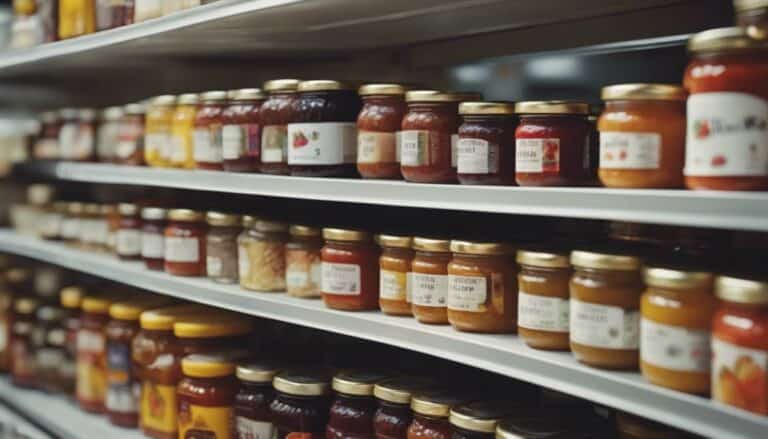Innovative preservation techniques and advanced additives are transforming the shelf life of value-added products. Learn about the crucial role of temperature control, pH regulation, preservatives, and packaging in extending product freshness beyond traditional methods. Explore how cutting-edge solutions like Nanopack, BARC, and eco-friendly packaging with antioxidant agents are revolutionizing product longevity. Discover the benefits of utilizing plant-based materials like rosemary extracts and smart antimicrobial surfaces for active packaging solutions. Uncover the importance of cold plasma technology, spray drying, and ionizing radiation in enhancing shelf life. Implementing these strategies can meet consumer demands for extended shelf life and high-quality standards.
Key Takeaways
- Proper temperature control is essential for extending shelf life.
- Utilize pH regulation to preserve the quality of value-added products.
- Incorporate preservatives to inhibit microbial growth and oxidation.
- Implement innovative packaging solutions for longevity.
- Explore advanced additives and treatment strategies for shelf-life enhancement.
Preservation Techniques for Extended Shelf Life
To maximize the shelf life of value-added products, implementing precise preservation techniques is essential. Extending the shelf life of food products is important for reducing food waste, maintaining product quality, and ensuring consumer satisfaction. Preservation methods such as temperature control, pH regulation, and the use of preservatives play a key role in shelf life extension. Proper packaging also contributes greatly to the longevity of products by protecting them from external factors that can lead to spoilage.
Preservatives are commonly used to inhibit microbial growth and prevent oxidation, thereby extending the shelf life of food products. Packaging integrity is crucial in preserving the sensory attributes and nutritional content of value-added products. By adhering to quality standards and regulatory requirements, businesses can enhance the market acceptance of their products. Implementing best practices in preservation techniques not only increases the shelf life of value-added products but also contributes to waste reduction and improved profitability.
Innovative Packaging Solutions for Product Longevity
Incorporating innovative packaging solutions is paramount for enhancing the longevity of value-added products in today's competitive market. Nanopack and BARC utilize halloysite nanotubes infused with essential oils and mango peels to create antimicrobial packaging, guaranteeing food safety and durability.
Companies like Advanta, StePac, and the University of Zaragoza offer eco-friendly packaging solutions with antioxidant agents to prolong the shelf life of value-added products. Ongoing research focuses on utilizing plant-based materials like extracts from rosemary, spearmint, and green tea to extend product longevity.
These innovative packaging solutions include plant-based or food-based materials in films, coatings, and nanoparticles, effectively slowing down spoilage and enhancing product longevity. Additionally, smart antimicrobial surfaces are being researched to develop active food packaging solutions that provide a safe and effective way to maintain product freshness and quality.
Utilizing Advanced Additives for Shelf-Life Enhancement
Exploring the application of advanced additives is essential for enhancing the shelf life of value-added products in the competitive market landscape. Researchers are delving into the field of utilizing plant-based essential oils and antioxidant nanoparticles to prolong the freshness of products.
Projects like Nanopack and BARC are innovatively incorporating mango peels and halloysite nanotubes into packaging materials to impart antimicrobial properties, ensuring products remain uncontaminated for longer periods.
Eco-friendly packaging solutions from Advanta, StePac, and University of Zaragoza are integrating antioxidant agents to extend the shelf life of these valuable products sustainably.
Additionally, ongoing studies focus on the potential of extracts derived from plants like rosemary, spearmint, and green tea as novel additives to enhance product longevity. The development of smart antimicrobial surfaces utilizing plant-based antimicrobial agents showcases a promising future for active food packaging solutions aimed at further extending the shelf life of value-added products.
Implementing Effective Food Treatment Strategies
Implementing advanced food treatment strategies such as cold plasma technology, ionizing radiation, and spray drying is essential for enhancing the shelf life and quality of value-added products. Ionizing radiation, specifically designed for microbe elimination on fruits and vegetables, plays an important role in ensuring food safety and extending longevity.
Additionally, spray drying techniques are being explored to preserve the freshness and quality of value-added products like milk and dairy items. These innovative food treatment methods not only aim to reduce spoilage but also to maintain product quality, meeting the increasing consumer demands for extended shelf life.
Strategies for Prolonging Shelf Life Economically
To economically extend the shelf life of value-added products, strategic implementation of proper packaging techniques is essential. Utilizing methods such as vacuum packaging or modified atmosphere packaging can effectively reduce oxidation and microbial growth, thereby prolonging product freshness and quality parameters. Incorporating natural preservatives, such as antioxidants or antimicrobial agents, can further enhance the shelf life of value-added products without guaranteeing their integrity.
Monitoring and controlling storage conditions, including temperature and humidity, play a critical role in economically extending the shelf life of these products.
Moreover, integrating smart labeling technologies for real-time monitoring of product freshness and quality can be a cost-effective strategy. These technologies provide valuable data that can help in making informed decisions regarding the handling and distribution of value-added products. By combining these approaches, businesses can optimize their processes to ensure longer shelf life for their products while maintaining high quality standards and meeting consumer expectations.
Conclusion
To sum up, through the integration of preservation techniques, innovative packaging solutions, advanced additives, and effective food treatment strategies, you can notably extend the shelf life of value-added products.
For instance, a study conducted by a leading food manufacturer found that by implementing a combination of modified atmosphere packaging and natural antimicrobial agents, they were able to increase the shelf life of their pre-cut fruits by up to 50%, resulting in reduced food waste and increased consumer satisfaction.

